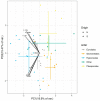Antifungal Activity of Glucosinolate-Derived Nitriles and Their Synergistic Activity with Glucosinolate-Derived Isothiocyanates Distinguishes Various Taxa of Brassicaceae Endophytes and Soil Fungi
- PMID: 37514355
- PMCID: PMC10383044
- DOI: 10.3390/plants12142741
Antifungal Activity of Glucosinolate-Derived Nitriles and Their Synergistic Activity with Glucosinolate-Derived Isothiocyanates Distinguishes Various Taxa of Brassicaceae Endophytes and Soil Fungi
Abstract
The glucosinolates of Brassicaceae plants are converted into bioactive isothiocyanates and other volatiles during a challenge by pathogens and other biotic stressors. However, the role of alternative downstream products with weaker potency (e.g., nitriles) is far from being fully understood. This study tested the possible synergistic antifungal interaction between various glucosinolate-derived nitriles and 2-phenylethyl isothiocyanate (PEITC) on 45 fungal strains, including endophytes from horseradish roots (Brassicaceae) and soil fungi, using an airtight system enabling the accurate study of extremely volatile antifungal agents. The median minimal inhibitory concentrations (MICs) were 1.28, 6.10, 27.00 and 49.72 mM for 1H-indole-3-acetonitrile (IAN), 3-phenylpropanenitrile (PPN), 4-(methylsulfanyl)-butanenitrile (MSBN) and 3-butenenitrile (BN, = allyl cyanide), respectively. Thus, nitriles were considerably weaker antifungal agents compared to PEITC with a median MIC of 0.04 mM. For the same nitriles, the median fractional inhibitory concentration indices (FICIs) of the combinations were 0.562, 0.531, 0.562 and 0.625, respectively. Altogether, 47.7%, 56.8%, 50.0% and 27.3% of tested fungal strains showed a synergistic antifungal activity (FICI ≤ 0.5) for the nitrile-isothiocyanate combinations, respectively. Hypocreales strains showed the least sensitivity towards the GSL decomposition products and their combinations. The mean MIC values for PEITC showed 0.0679 ± 0.0358, 0.0400 ± 0.0214, 0.0319 ± 0.0087 and 0.0178 ± 0.0171 mM for Hypocreales, Eurotiales, Glomerellales and Pleosporales, respectively. In addition, nitriles, especially IAN, also showed significant differences. For the same fungi, the median FICI values fell in the ranges of 0.61-0.67, 0.52-0.61, 0.40-0.50 and 0.48-0.67, respectively, depending on the nitrile. Our results suggest that glucosinolate-derived nitriles may enhance isothiocyanate antifungal activity and that they may play an active role in shaping the plant microbiome and contribute to the filtering of microbes by plants.
Keywords: ITC; antifungal activity; endophyte fungi; isothiocyanate; nitrile; soil fungi; synergy.
Conflict of interest statement
The authors declare no conflict of interest.
Figures


Similar articles
-
Endophytic fungi from the roots of horseradish (Armoracia rusticana) and their interactions with the defensive metabolites of the glucosinolate - myrosinase - isothiocyanate system.BMC Plant Biol. 2018 May 9;18(1):85. doi: 10.1186/s12870-018-1295-4. BMC Plant Biol. 2018. PMID: 29743024 Free PMC article.
-
Interactions of fungi with non-isothiocyanate products of the plant glucosinolate pathway: A review on product formation, antifungal activity, mode of action and biotransformation.Phytochemistry. 2022 Aug;200:113245. doi: 10.1016/j.phytochem.2022.113245. Epub 2022 May 24. Phytochemistry. 2022. PMID: 35623473 Review.
-
Correlations Between the Metabolome and the Endophytic Fungal Metagenome Suggests Importance of Various Metabolite Classes in Community Assembly in Horseradish (Armoracia rusticana, Brassicaceae) Roots.Front Plant Sci. 2022 Jun 17;13:921008. doi: 10.3389/fpls.2022.921008. eCollection 2022. Front Plant Sci. 2022. PMID: 35783967 Free PMC article.
-
Biological Effects of Glucosinolate Degradation Products from Horseradish: A Horse that Wins the Race.Biomolecules. 2020 Feb 21;10(2):343. doi: 10.3390/biom10020343. Biomolecules. 2020. PMID: 32098279 Free PMC article.
-
Glucosinolate derivatives as antifungals: A review.Phytother Res. 2024 Nov;38(11):5052-5066. doi: 10.1002/ptr.8307. Epub 2024 Aug 5. Phytother Res. 2024. PMID: 39101575 Review.
Cited by
-
Antimicrobial Potential of Polyphenols: Mechanisms of Action and Microbial Responses-A Narrative Review.Antioxidants (Basel). 2025 Feb 10;14(2):200. doi: 10.3390/antiox14020200. Antioxidants (Basel). 2025. PMID: 40002386 Free PMC article. Review.
References
-
- Plaszkó T., Szűcs Z., Vasas G., Gonda S. Interactions of Fungi with Non-Isothiocyanate Products of the Plant Glucosinolate Pathway: A Review on Product Formation, Antifungal Activity, Mode of Action and Biotransformation. Phytochemistry. 2022;200:113245. doi: 10.1016/j.phytochem.2022.113245. - DOI - PubMed
Grants and funding
LinkOut - more resources
Full Text Sources

